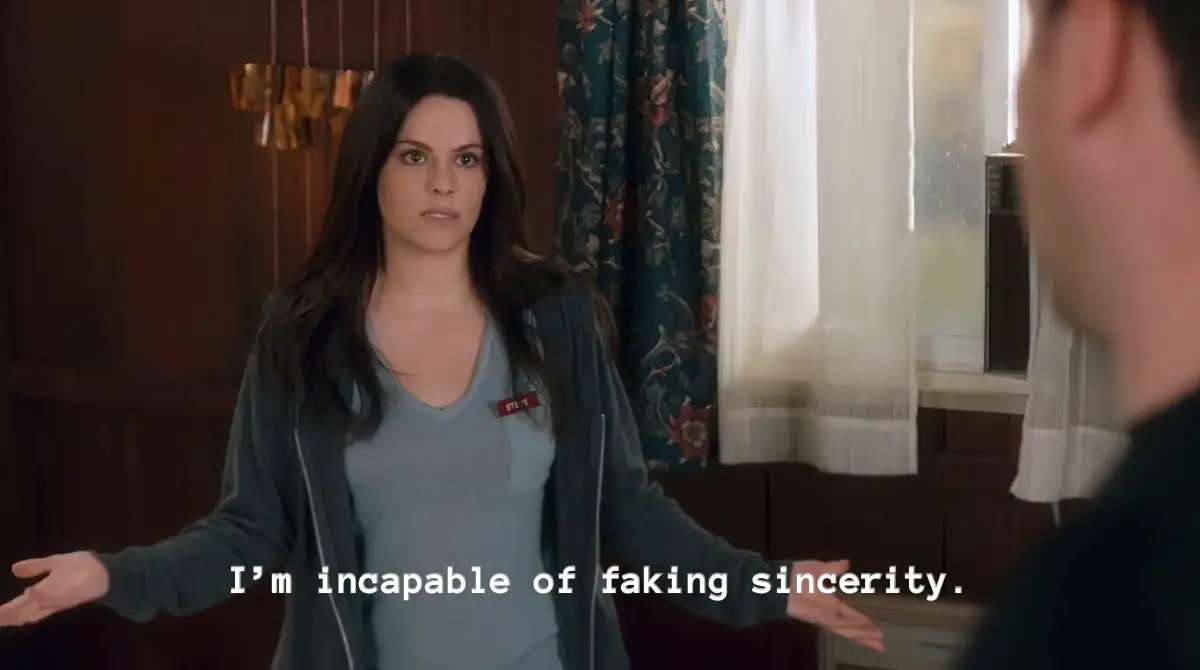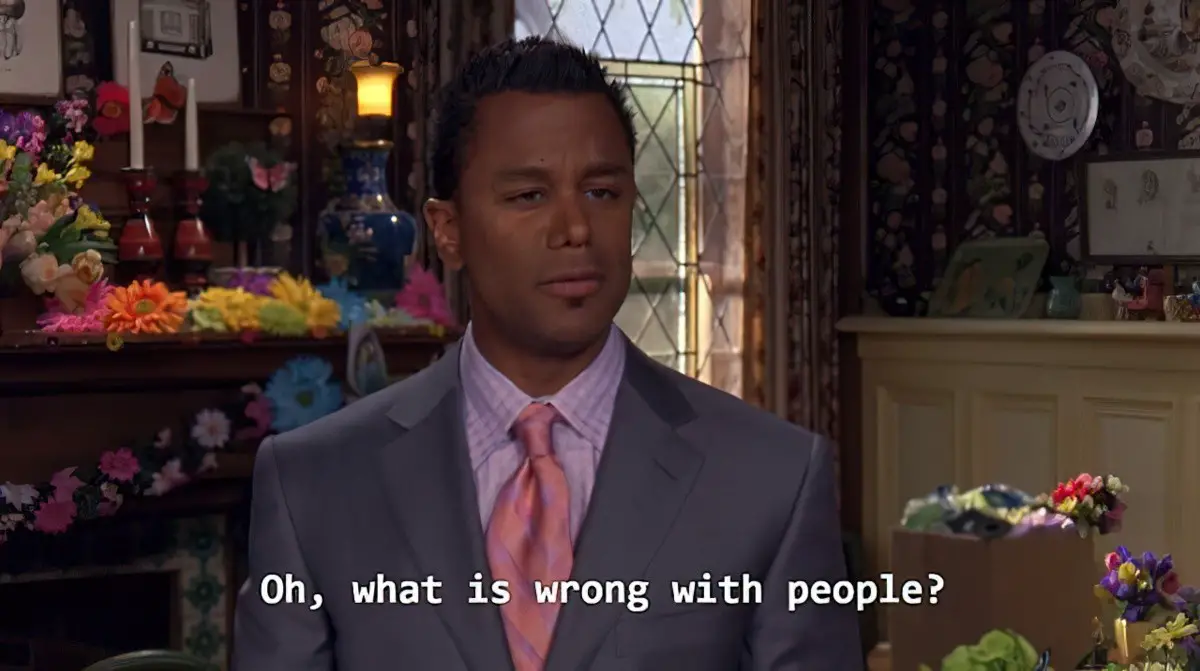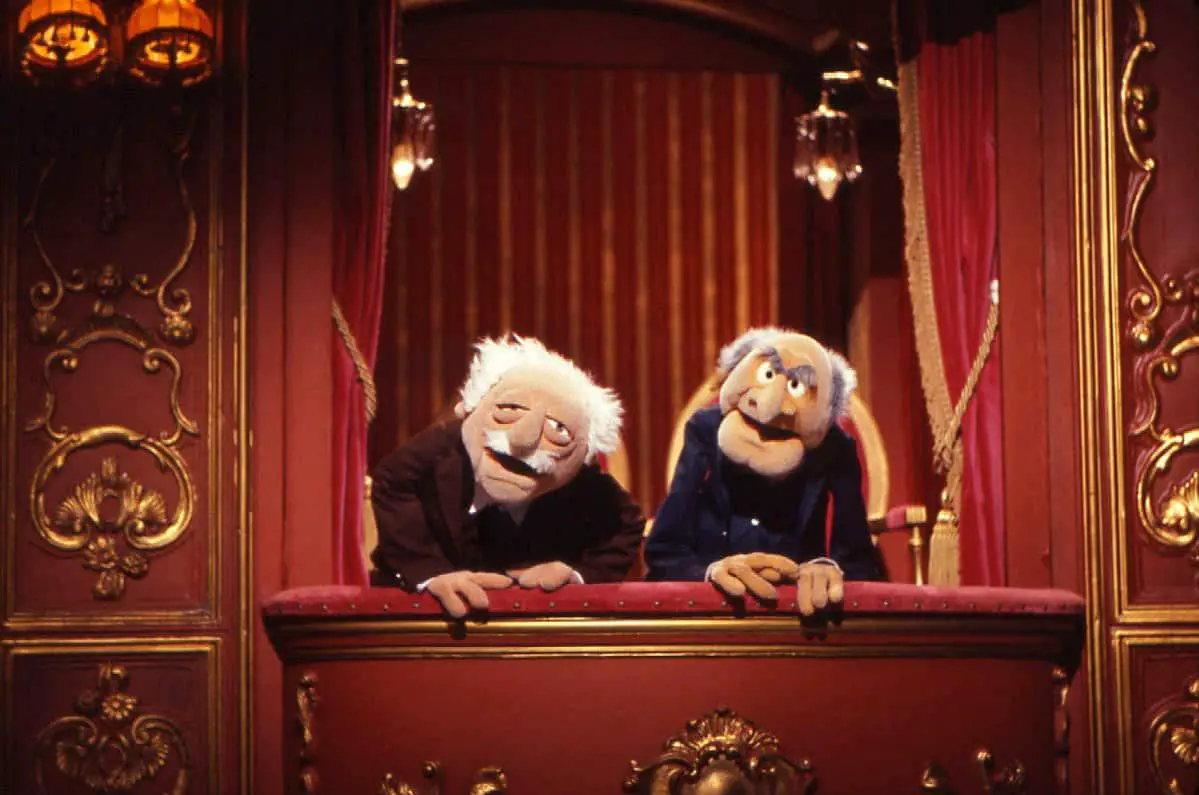WHAT IS A CHORIC FIGURE?
CHORIC FIGURE: Any character in any type of narrative literature that serves the same purpose as a chorus in drama by remaining detached from the main action and commenting upon or explaining this action to the audience. I’ve also seen ‘choral commentator’ and guess it means the same thing.
It may be useful to think of choric figures in terms of a continuum rather than ‘choric commentators’ and all the other characters. That said, a ‘normal’ character can morph into a choric commentator. See below for an example from Charlotte’s Web.
At the ‘very choric’ end of that continuum we’ve got Statler and Waldorf from The Muppets, who literally sit in the audience. Whenever we see them, they are spatially removed from the ‘show’, and they remind the real audience that we are watching a show. Their commentary is therefore meta.

DESIGNATED NORMAL CHARACTERS IN COMEDIES
Then there’s Stevie Budd from Schitt’s Creek, the designated ‘normal’ character in a cast full of oddballs. In the final episode of one season of Schitt’s Creek, Stevie says that she feels like crying. She says this to ‘no one’ in particular; she says it to us, and Stevie’s emotion successfully evokes pathos in the audience. Importantly, Stevie Budd very much has a personality of her own, but if anyone’s going to be offering sarcastic commentary, it’ll be Stevie (and also David).

Gilmore girls also has a choric figure who works behind the counter (of a motel, not a hotel.) Yes. That would be Michel.

Jerry Seinfeld is the designated normal character of Seinfeld, and what he says, what he observes (as part of his stand-up routine) is a choric commentary on the absurdity of life, embodied by his friends and their disastrous dating escapades.
Jim and Pam of the The Office are not-exactly-subtle choric characters because the structure of the comedy allows characters to break the fourth wall and address the audience directly.
The Designated Normal character of This Country is the Vicar.
Basically, these choric characters say whatever the writers expect the audience might be thinking. They issue sensible advice the audience would likely give. The designated normal character is inherently relatable and very useful. Oddball characters can be alienating, and when an audience sees there’s a ‘normal’ person who loves them, this helps us to love them, too.
The Designated Normal character is also useful for various types of lampshading. “Now WHAT are you planning? Isn’t that utterly ridiculous?” The Designated Normal thereby functions to highlight the warped logic of the screwball characters, who must nevertheless run according to their own internal logic. Their internal logic must somehow be made apparent to an audience.
The Designed Normal character is also used as a Straight Man, of course.
For an example in a novel, check out chapter one of Such A Fun Age by Kiley Reid. The main character, who is Black, takes her young, white babysitting charge to the supermarket and is accosted for suspected wrong-doing by a Nice White Lady and a security guard. The choric figure is a dude standing nearby, filming the entire thing on his phone. He is us. He is teaching the audience (who may need it) to be properly outraged at the spectacle racism, but also embodies bystanders who think they’re being helpful but aren’t. Via this guy with the phone camera, Kiley Reid satirizes white wokeness.
THE SUBTLE END OF THE CHORIC CONTINUUM
Now for some much more subtle examples of choric characters.
I consider the ‘new kid in town’ (or the ‘new dead kid’ an example of a choric character in the sense that they are new to the situation and as baffled as the audience. There’s a good narrative reason why stories often begin with a character moving to a new house or to a new school. The narrator can realistically observe and comment upon the things they are seeing all around them, things which would be normal and non-noteworthy if they were already acclimatised to this particular setting.
Sometimes with a story on screen, it’s not so much in the writing as in the acting. Chloë Grace Moretz is known among critics for an acting style which often makes her seem alien in her fictional environment, as perplexed as we are. Her performance in If I Stay, based on the young adult novel by Gayle Forman, is a good example of that. She looks bewildered at events playing out before her. (She’s the perfect choice; she’s newly dead.) Like her audience, she is trying to work out what’s going on.
Now for a completely different kind of subtle chorus. In Charlotte’s Web by E.B. White there are not Statler and Waldorf commentators but in his Annoted Guide, Peter Neumeyer points out two choral commentators.
The first is Dr. Dorian, who tells Fern’s mother (and also the reader) that we should believe in magic such as animals talking in a barn. Wise owls are often used in this way by children’s book writers, though sometimes their wisdom is subverted (e.g. in Winnie-the-Pooh).
Next Charlotte takes his place by morphing into a choric commentator, though it’s very subtle.
“What’s inside it?” asked Wilbur. “Eggs?”
E.B. White, Charlotte’s Web
“Five hundred and fourteen of them,” she replied.
Perhaps the shift in Charlotte’s narrative use is because she’s approaching death.
There’s this idea that people approaching death have achieved some kind of greater insight into life matters in general. Whether this is true in reality is debatable, but in storytelling writers milk this idea. Hence, as Charlotte sees her impending death, she achieves The Overview Effect and is able to see ‘the circle of life’ and be content with it, guiding Wilbur through his Being-toward-death enlightenment in the process. (Her egg sac will let her achieve immortality.)
Characters approaching death are perhaps more often used by storytellers as choral commentators, even when previously they didn’t seem to have any advantageous insight into life matters.
Katherine Mansfield utilised a choric figure in her short story “Marriage a la Mode“. One of her characters creates witty titles for yet-to-be-made works of art. It’s unclear whether this character is being earnest or ironic, but that doesn’t matter. The effect on the reader is the same: Pointing out the ridiculousness of these artists for the reader.
USEFUL TERM
Reaction shot. From the movies, a cutaway shift inside a bundle of narrative action which shows us the emotional or other responses of a character, usually a reader surrogate.
Glossary of Words Useful When Critiquing Science Fiction
RELATED
There are many ways of thinking about narration. Another continuum, oft talked about: the psychic distance continuum. In this post I’ve been talking about the distance between a particular, designated ‘audience/cast member’ character. This describes how that character emotionally aligns with the audience. (The relationship between character and audience.)
Psychic distance instead describes how fully a third-person, unseen narrator is inside a character’s head. (The relationship between narrator and character.) Psycho narration happens when a narrator is right inside a character’s head.
Commentators have used the words ‘dissonant’ and ‘consonant’ to describe the degree to which a narrator is inside a character’s head at any given moment, noting that it shifts as a story progresses. We might use those same words to describe the choric figure. Sometimes they seem like another ordinary member of the cast (dissonant), but the writer can jerk them partly off stage and use them as a proxy audience member if needs be (consonant).
I’m sure narratologists have talked about this but, heigh ho, this is how I think of it.

